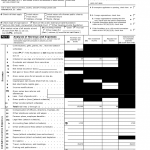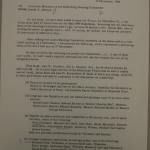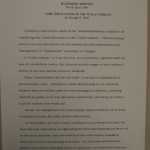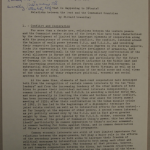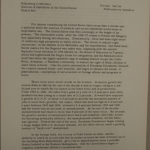The 69th Bilderberg Meeting will take place from 18 – 21 May 2023 in Lisbon, Portugal. About 130 participants from 23 countries have confirmed their attendance. As ever, a diverse group of political leaders and experts from industry, finance, academia, labour and the media has been invited.
2122 search results for "bil"
China, United States
China EMP Threat: The People’s Republic of China Military Doctrine, Plans, and Capabilities for Electromagnetic Pulse (EMP) Attack
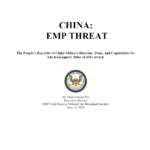
China has long known about nuclear high-altitude electromagnetic pulse (HEMP) and invested in protecting military forces and critical infrastructures from HEMP and other nuclear weapon effects during the Cold War, and continuing today. China has HEMP simulators and defensive and offensive programs that are almost certainly more robust than any in the United States. China’s military doctrine regards nuclear HEMP attack as an extension of information or cyber warfare, and deserving highest priority as the most likely kind of future warfare.
Department of Homeland Security, Federal Bureau of Investigation, National Counterterrorism Center
(U//FOUO) DHS-FBI-NCTC Bulletin: Dissemination of Tactics, Techniques, and Procedures Used by Buffalo Attacker Likely To Enhance Capabilities of Future Lone Offenders
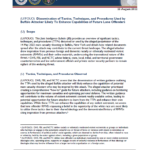
This Joint Intelligence Bulletin (JIB) provides an overview of significant tactics, techniques, and procedures (TTPs) discussed or used by the alleged perpetrator of the 14 May 2022 mass casualty shooting in Buffalo, New York and details how related documents spread after the attack may contribute to the current threat landscape. The alleged attacker drew inspiration from previous foreign and domestic racially or ethnically motivated violent extremists (RMVEs) and their online materials, underscoring the transnational nature of this threat. DHS, FBI, and NCTC advise federal, state, local, tribal, and territorial government counterterrorism and law enforcement officials and private sector security partners to remain vigilant of this enduring threat.
Department of Homeland Security, Federal Bureau of Investigation, National Counterterrorism Center
DHS-FBI-NCTC U.S. Violent Extremist Mobilization Indicators 2021 Edition
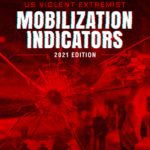
This resource is provided to inform law enforcement, terrorism prevention practitioners, other first responders, community leaders, as well as the general public about both threats of violence and contextual behaviors that suggest an individual is mobilizing to violence. While some violent extremists may make direct, indirect, or vague threats of violence, others may plot violent action while avoiding such overt threats to maintain operational security—underscoring the need to consider both threats of violence and contextual behaviors.
Bilderberg Participant Lists
2022 Bilderberg Meeting Participant List
The 68th Bilderberg Meeting will take place from 2 – 5 June 2022 in Washington, D.C., USA. About 120 participants from 21 countries have confirmed their attendance. As ever, a diverse group of political leaders and experts from industry, finance, academia, labour and the media has been invited.
Department of Homeland Security
(U//FOUO) DHS Bulletin: APT Actors Likely View Zoom Vulnerabilities as Opportunity to Threaten Public and Private Sector Entities
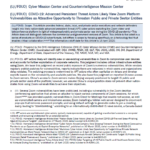
APT actors likely will identify new or use existing vulnerabilities in Zoom to compromise user devices and accounts for further exploitation of corporate networks. This judgment includes critical infrastructure entities using Zoom. We base this judgment on recent public exposure of Zoom’s numerous vulnerabilities. While vendors regularly publish patches for vulnerabilities, reports indicate there are instances in which users and organizations delay updates. The patching process is undermined by APT actors who often capitalize on delays and develop exploits based on the vulnerability and available patches.
Federal Bureau of Investigation
FBI Cyber Bulletin: Targeting of Audio and Visual Communication Devices on Business Networks to Identify Vulnerabilities for Exploitation
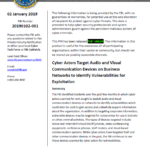
The FBI identified incidents over the past few months in which cyber actors scanned for and sought to exploit audio and visual communication devices on networks to identify vulnerabilities which could later be used to gain access and unlawfully acquire information about the organization. In addition to targeting corporate information, vulnerable devices may be targeted for compromise for use in botnets or other criminal activities. The types of devices targeted include: Voice over Internet Protocol (VoIP) phones, video conferencing equipment, conference phones, VoIP routers, and cloud-based communication systems. While cyber actors have targeted VoIP and other communication devices in the past, the FBI continues to see these devices scanned by cyber actors for vulnerabilities.
Bilderberg Participant Lists
2019 Bilderberg Meeting Participant List
The 67th Bilderberg Meeting will take place from 30 May – 2 June 2019 in Montreux, Switzerland. About 130 participants from 23 countries have confirmed their attendance. As ever, a diverse group of political leaders and experts from industry, finance, academia, labour and the media has been invited.
Defense Intelligence Agency
(U//FOUO) DIA Study: Invisibility Cloaking Theory and Experiments
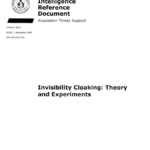
The idea of invisibility has fascinated people for millennia, inspiring many myths, novels, and films. Invisibility cloaking has recently become a subject of science and technology. This paper describes the important current theoretical and experimental developments and tries to project into the future.
Department of Energy
Department of Energy Assessment of Electricity Disruption Incident Response Capabilities
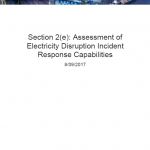
Electricity is critical to every aspect of modern life. The United States’ national security, economy, and public health and safety rely on the North American electric grid every second of the day. These, and many other functions powered by the grid have likely experienced local outages caused by weather, accidents, or sometimes from tree branches falling on power lines. Larger power outages, however, are infrequent occurrences, due in part to an array of organizations that work tirelessly to ensure the grid remains reliable, resilient, and secure. Nonetheless, it is neither practical nor possible to prevent all disruptive events. Grid owners and operators balance risk, investment, and cost to customers when making investments in their systems.
Bilderberg Participant Lists
2018 Bilderberg Meeting Participant List
The 66th Bilderberg Meeting is set to take place from 7-10 June 2018 in Turin, Italy. As of today, 131 participants from 23 countries have confirmed their attendance. As ever, a diverse group of political leaders and experts from industry, finance, academia and the media has been invited.
White House
Vulnerabilities Equities Policy and Process for the United States Government
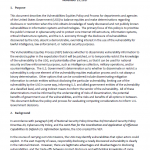
This document describes the Vulnerabilities Equities Policy and Process for departments and agencies of the United States Government (USG) to balance equities and make determinations regarding disclosure or restriction when the USG obtains knowledge of newly discovered and not publicly known vulnerabilities in information systems and technologies. The primary focus of this policy is to prioritize the public’s interest in cybersecurity and to protect core Internet infrastructure, information systems, critical infrastructure systems, and the U.S. economy through the disclosure of vulnerabilities discovered by the USG, absent a demonstrable, overriding interest in the use of the vulnerability for lawful intelligence, law enforcement, or national security purposes.
Department of Homeland Security
(U//FOUO) DHS Report: Ransomware Goals of Malicious Actors and Current System Vulnerabilities
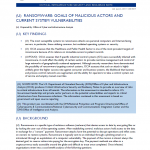
OCIA assesses that if specific industrial control systems (ICS) were successfully infected with ransomware, it could affect the ability of certain sectors to provide real-time management and control of large networks of geographically scattered equipment. Although security researchers have demonstrated the possibility of ransomware targeting control systems, OCIA assesses that such an attack is highly unlikely given the higher success rate against consumer and business systems, the likelihood that business and process control networks are segmented, and the ability for operators to take a control system out of service and employ manual overrides.
Bilderberg
Bilderberg Association Annual Report 2016
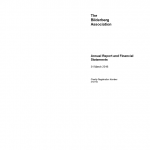
An annual report for the Bilderberg Association from 2016 made available through the U.K. Charities Commission. The Bilderberg Association is one of several international non-profit affiliates of the group known as Bilderberg Meetings. The U.S. affiliate is called American Friends of Bilderberg, Inc. and is a registered non-profit in the State of New York.
Bilderberg
Bilderberg Association Annual Report 2015
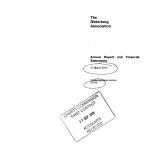
An annual report for the Bilderberg Association from 2015 made available through the U.K. Charities Commission. The Bilderberg Association is one of several international non-profit affiliates of the group known as Bilderberg Meetings. The U.S. affiliate is called American Friends of Bilderberg, Inc. and is a registered non-profit in the State of New York.
Bilderberg
American Friends of Bilderberg 2015 Tax Return
Bilderberg
American Friends of Bilderberg 2014 Tax Return
Bilderberg Participant Lists
2017 Bilderberg Meeting Participant List
The 65th Bilderberg Meeting will take place from 1-4 June 2017 in Chantilly, Virginia, USA. As of today, 131 participants from 21 countries have confirmed their attendance. As ever, a diverse group of political leaders and experts from industry, finance, academia and the media has been invited.
Bilderberg Archive
Robert Murphy Steering Committee Correspondence Related to 1969 Bilderberg Meeting
Bilderberg Archive
Bilderberg Discussion Paper: Some Reflections on the Japanese at Aspen
Bilderberg Archive
Bilderberg Discussion Paper: Some Implications of the World Company
Bilderberg Archive
Bilderberg Discussion Paper: What is Happening to Detente? Relations Between the West and the Communist Countries
Bilderberg Archive
Bilderberg Discussion Paper: Sources of Instability in the United States
Bilderberg Archive
Bilderberg Discussion Paper: Deluded Strategies in the Twilight of the Cold War
Department of Energy
Idaho National Laboratory Cyber Threat and Vulnerability Analysis of the U.S. Electric Sector
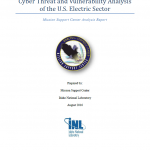
With utilities in the U.S. and around the world increasingly moving toward smart grid technology and other upgrades with inherent cyber vulnerabilities, correlative threats from malicious cyber attacks on the North American electric grid continue to grow in frequency and sophistication. The potential for malicious actors to access and adversely affect physical electricity assets of U.S. electricity generation, transmission, or distribution systems via cyber means is a primary concern for utilities contributing to the bulk electric system. This paper seeks to illustrate the current cyber-physical landscape of the U.S. electric sector in the context of its vulnerabilities to cyber attacks, the likelihood of cyber attacks, and the impacts cyber events and threat actors can achieve on the power grid. In addition, this paper highlights utility perspectives, perceived challenges, and requests for assistance in addressing cyber threats to the electric sector.

